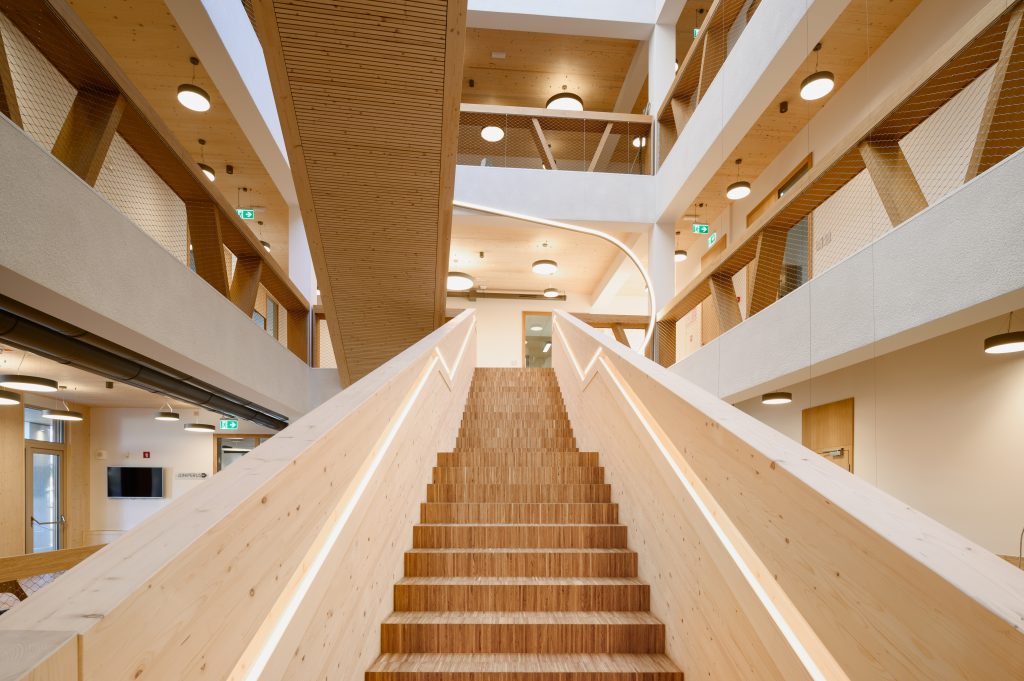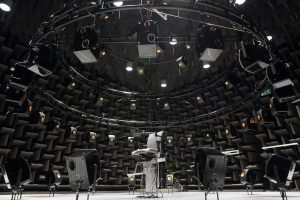
January 7, 2026

At InnoRenew CoE, we have recently started our research in the field of virtual acoustic environments. Using virtual acoustic environments for acoustic investigations has become common in the last decade, making it a relatively new research approach worth describing. Specifically, its application to room acoustics is presented, which is essential for a healthy and creative working environment – one of the important research topics at our institute.
Room or architectural acoustics investigate and design a room’s geometry, its boundaries and elements, to establish a high-quality acoustic environment. To master this process, it is fundamental to understand the physics of sound – how it generates, propagates and interacts with bounding surfaces. Room acoustic measurements and modeling techniques are used as tools to define acoustic treatment, commonly in the form of acoustic cladding, improved room geometry, optimized choice of seats, etc. All design solutions are determined in collaboration with architects and other engineers involved in the design process.
But what does a high-quality acoustic environment actually mean? Well, this is the central research question in room acoustics that can be most effectively approached using virtual acoustic environments. High-quality acoustics are quantified by room acoustic parameters, such as reverberation time, that satisfy subjective preferences. In search of this, it is essential to identify and consider those room acoustic properties that are of importance to users of each type of room.
Current guidelines exist for acoustic design, and we can look at how they have been established for concert halls.
Concert halls are unquestionably among the most acoustically sophisticated environments that have been defined through a long and rich history of music performance. Orchestra has a well-defined form with specified instruments, number of musicians and location of the conductor. Dr. Leo Beranek[i] is the pioneer for defining acoustic properties of the best concert halls.
Dr. Beranek obtained a broad range of measured acoustic parameters for 58 concert halls spread over the world. He defined a questionnaire that was given to musicians, musical critics, conductors and music enthusiasts that asked for their preferences about the acoustics in their concert halls. A special vocabulary was developed, including whether the sound was loud enough, clear enough or reverberant. Based on the given marks, the concert halls have been ranked form best to worst. The last updated list of Beranek’s ranking was published in “The Journal of the Acoustical Society of America” in 2016.

Musikvereinssaal (Vienna), best concert hall according to Beranek’s 2016 list. Those that follow: 2. Boston, Symphony Hall; 3. Amsterdam, Concertgebouw; 4. Berlin, Konzerthaus; 5. Tokyo, Opera City Concert Hall; 6. Basel, Stadtcasino; 7. Birmingham, Symphony Hall; 8. Lucerne, Kultur- und Kongresszentrum; 9. Cardiff, St. David’s Hall; 10. Dallas, Morton H. Meyerson Symphony Center. Photo: Bwag/Wikimedia
Once the best concerts halls are known, it is possible to separate the best ones and seek relationships between their physical properties. For example, looking at the room’s volume and corresponding values of an acoustic parameter. Such empirical relations are used as guidelines for room acoustic design in concert halls. By following the guidelines, we can also expect that a newly built hall will fit into the group of best concert halls. Similar guidelines exist today for various types of rooms, including theaters, classrooms, listening rooms, lecture rooms and so on.
As shown later[ii], some important factors influencing obtained results can simply not be controlled by using Dr. Beranek’s approach. Among those is the time difference between each concert experience individuals are questioned about. It turns out that acoustic memory is strongly affected by the time that has passed since each concert. To avoid this effect, the listener and orchestra should able to physically transfer between concert halls immediately, which will not be possible before the invention of teleportation.
It was also discovered that most conductors favor their own concert halls, i.e., the hall that is the home of their orchestra. This might be due to a form of loyalty (or to improve ticket sales), but it can also be the effect of long rehearsals in the same hall. Conductors get used to and familiar with their concert hall’s acoustics and are, therefore, able to critically control the orchestra. This leads to a favorable mark in the survey.
Furthermore, individuals differ in their awareness of certain room acoustic characteristics, their sensitivity and knowledge. Those and other factors influence opinions, which can also be biased and change with time. All of this makes the inclusion of individuals into the research challenging but interesting.
On the other hand, underestimation of subjective factors influencing the survey’s outcome is not the only critic of the approach. The sample of concert halls subject to grading is limited, very often only to concert halls built centuries ago. Since then, building technology has developed and the range of available finishing materials has expanded. Therefore, design guidelines obtained on this basis can only direct room acoustics in the range of already built concert halls, meaning nothing revolutionary can be built based on this approach. My personal opinion is that this limitation holds back the development of room acoustics. As shown by history several times, setting foot into the unknown is the key to progress.
In this perspective, it is controversial that the acoustic design guidelines obtained as described are subject to further research and included in legislation – even in Slovenia[iii]. It seems that quantitative norms give us comfort whether they make sense or not. In my personal opinion, such guidelines can be used as an additional point of orientation but only if we are aware of how they have been obtained and if common sense is applied.
Studies concerned with acoustic preferences are difficult to conduct. The proper approach is to fully understand that, in this case, the human is part of the studied system, which introduces uncertainties and risks that have to be managed.
Virtual acoustic environments can help to achieve this goal. So, what are virtual acoustic environments? Physically, it is a laboratory room with a weak acoustic response. The established sound field in it is produced by a large number of loudspeakers and, as such, is under our control. At InnoRenew CoE, we have an ambisonsics reproduction system where the loudspeakers are in a spherical configuration surrounding the listener. If each of the system’s loudspeakers is fed with a properly adjusted signal, it is possible to establish a sound wave in the center of the sphere that propagates from any direction.

InnoRenew CoE’s recently acquired ambisonics sound system is similar to the one at the Technical University of Denmark (https://www.elektro.dtu.dk/english/research/research-facilities/avil, pictured their Hearing System) and will be part of the acoustic laboratory in our new building. Photo: Naim Mansour
InnoRenew CoE’s recently acquired ambisonics sound system is similar to the one at the Technical University of Denmark (pictured) and will be part of the acoustic laboratory in our new building. Photo: Torben Nielsen
The capability to reproduce the direction characteristics of sound is the key property of the ambisonic system. This enables an “immersive sound effect”, giving the impression to listeners of being located in a different – virtual – acoustic environment.
Additionally, environments being reproduced in an ambisonics system must also be properly recorded. To preserve the direction information of sound, a microphone with a high number of microphone capsules in a spherical configuration is used. Furthermore, acoustic environments can also be generated based on computer simulations. As such, purely fictive soundscapes can be created, which opens up further options for using the system.

The ambisonics loudspeaker and microphone system as part of InnoRenew CoE’s acoustic laboratory. Photo: Rok Prislan
Getting back to concert halls, Dr. Tapio Lokki[4][iv] has reproduced, with his research group, a recording of the same orchestra recorded in several different concert halls to individuals in a virtual acoustic environment. Listeners could easily and quickly move between concert halls and judge their acoustics, without actually knowing which one was the virtually recreated hall (here you can find the video recording of his lectures on virtual acoustics).
Virtual acoustic environments are not limited to room acoustics. For example, it is possible to simulate noisy office environments and investigate the benefits of a barrier between workers. Does such a barrier improve working conditions enough? What about a poorly sound isolated wall shared with a noisy neighbor – does it make sense to soundproof it with an additional isolation layer it or will we still understand the topic of a fight in the neighboring dwelling? We are approaching this and many other research questions in the acoustic laboratory of InnoRenew CoE.
Dr Rok Prislan,
researcher at the InnoRenew CoE
Literature
[i] L. Beranek, Concert Halls and Opera Houses, Springer New York (2004), New York.
[ii] T. Lokki, Tasting music like wine: Sensory evaluation of concert halls, Physics Today 67(1), p. 27, 2014 (https://doi.org/10.1063/PT.3.2242).
[iii] Tehnična smernica: TSG-1-005:2012, Zaščita pred hrupom v stavbah (https://www.gov.si/assets/ministrstva/MOP/Dokumenti/Graditev/tsg_005_zascita_pred_hrupom.pdf, 24. 4. 2020).
[iv] T. Lokki, Throw Away That Standard and Listen: Your Two Ears Work Better, Building Acoustics 20(4), p. 283–293, 2013 (https://doi.org/10.1260/1351-010X.20.4.283).